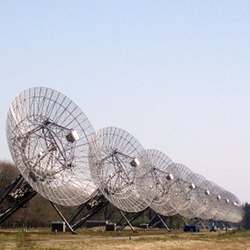
These days, fast radio bursts (FRBs) are one of the hottest mysteries in astronomy.
FRBs are intense extragalactical point-sources of radiation at radio wavelengths lasting only milliseconds and of unknown origin; only a few dozen have ever been detected. An FRB might result from a cataclysmic event on a neutron star, or something else entirely, but each FRB's release of energy in milliseconds equals the energy output of the sun over several years. As there is no pattern to where they flare up in the sky, detecting them is a matter of having a wide angle 'lens' on your radio telescope, with a very short shutter time, and luck.
Very few telescopes have those capabilities, but the recent upgrade of the Westerbork Synthesis Radio Telescope (WSRT) took care of this. Each of the system's 12 active large parabolic dishes got a new radio receiver that acts as the equivalent of the CCD-chip in an optical camera.
'We were lucky that the design of the Westerbork telescope allowed us to put these receivers in,' says Joeri van Leeuwen, astrophysicist at ASTRON, the Netherlands Institute for Radio Astronomy.
The line-up of the 12 connected dishes acts in some respects as one dish with a 3-km (nearly 2-mile) diameter, which provides excellent angular resolution, and the capability to capture 10,000 image-frames of the sky per second.
Van Leeuwen expects the telescope will be able to spot an FRB about once a week.
Real time data processing
To make this possible, wide-angle radio receivers are not enough. The upgraded telescope generates 3.7 terabits of data per second night and day, a data stream so large that it has to be processed in real time by a supercomputer dubbed Apertif Radio Transient System (ARTS), with a capacity of 2 petaflops.
Glass fibers feed raw data from the telescope's dishes into a stack of field-programmable gate arrays (FPGAs) for initial processing. From there, 50 40GBit/s Ethernet cables connect to a cluster of Graphics Processing Units (GPUs), the chips that power game computers, which specialize in parallel data processing, exactly what is needed to generate high-resolution images in fast action video games.
The ARTS cluster uses 200 off-the-shelf GPUs. Because the telescope data is only 8-bit, ARTS did not need more advanced 64-bit GPUs, van Leeuwen said. "Using the cheap 32-bit GPU's, we built a supercomputer that was 10 times as powerful for the given budget."
De-dispersion
Most of the computing power goes into 'de-dispersion,' or correcting for dispersion. At its origin, an FRB is a millisecond spike of radio waves in a range of wavelengths, but travelling through millions of light years of intergalactic space, the short wavelengths travel a tiny bit faster than the long ones, so the spike gets smeared in time (dispersed) over several seconds.
The first step in detecting an FRB in the flood of data being downloaded from the sky is reversing the dispersion. As the amount of dispersion depends on the unknown distance to the FRB, this involves a lot of trial and error; a task, says Van Leeuwen, that is "embarrassingly parallel."
After de-dispersion, the data stream has been reduced sufficiently to save all candidate events to memory, and a suspected FRB will show up as a single pixel that flares up in the wavelengths between 1,200 MHz and 1,500 MHz.
Very few will turn out to be real; anyone in the telescope area who forgets to switch off a Bluetooth device will generate noise that may overwhelm the FRB signals.
Even at this stage, humans will not look at the incoming data. A machine learning algorithm that has been trained on known FRBs makes a selection, and will only give an alert for the 0.1% of images that constitute the most promising candidates.
Robotic telescopes
To discover the origin of FRBs, it is necessary to examine them with optical, X-ray, and infrared telescopic sensors, but they last only milliseconds in radio waves, and the optical counterpart of an FRB might be gone in seconds or minutes. Telescope-connected supercomputers now can connect to robotic telescopes all over the world, and zoom in on the patch of sky where an FRB is detected in seconds. Said Van Leeuwen, "We still need to agree on the confidence level for a candidate FRB, because we don't want to flood these robotic telescopes with false alerts.'
The team at ASTRON is part of an international collaboration that already is designing the next generation of telescope supercomputers. MeerKAT, a radio telescope in South Africa with a computer very similar to ARTS, began operating in 2016, with 16 of its eventual 64 satellite dishes working. By 2025, MeerKAT will be expanded into the Square Kilometre Array (SKA), a giant radio telescope split over three locations in South Africa, New Zealand, and Australia.
According to William Garner, director of communications at SKA, their supercomputer will "likely be some evolution of this design." Early in February, the concept passed its "critical design review." It will have to process three times as much data as ARTS, using an architecture with 500 nodes, each having one GPU card and one FPGA board.
It's fair to say for astronomy in general, the next step forward depends as much on faster supercomputing and robotics as on better and bigger telescopes.
Arnout Jaspers is a freelance science writer based in Leiden, the Netherlands.



Join the Discussion (0)
Become a Member or Sign In to Post a Comment